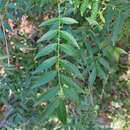zh-TW
在導航的名稱


Zanthoxylum coco (also known as Fagara coco) is an evergreen tree of the family Rutaceae, native to Argentina and Bolivia where it grows in the wild, mostly in spiniferous forests of the low mountain ranges of the western Chaco. It is characteristic of the hill forest of the Sierras Pampeanas.
The coco, also cochucho or smelly sauco, is usually found either in isolated groups or standing alone, from a small to medium-sized tree, ranging from 6 to 8 metres in height. The foliage is abundant, evergreen with imparipinnate leaves that present paired spines presumably in the place of leaflets. Punctations, in pairs, on the leaflets are quite distinctive. Leaves have serrated margins and pinnate venation. Flowers have five petals and are arranged in paniculate inflorescences. The fruit is spherically shaped, dehiscent; containing a shiny blackish seed.[2] The whole plant has a characteristic unpleasant smell, hence the alternative name "smelly sauco".[3]
Even though unused in the general botanical pharmacopeia, Zanthoxylum coco tissues are very rich in alkaloids. γ-Fagarine, N-methylisocorydine, skimminianine, α-fagarine, fagarine-2, magnoflorine, nitidine, chelerythrine, berberine, palmatine and candicine have been isolated from the foliage and wood.[4]
The coco belongs to the genus Zanthoxylum. However, most local scientific articles use Fagara as the genus name.
Zanthoxylum coco (also known as Fagara coco) is an evergreen tree of the family Rutaceae, native to Argentina and Bolivia where it grows in the wild, mostly in spiniferous forests of the low mountain ranges of the western Chaco. It is characteristic of the hill forest of the Sierras Pampeanas.